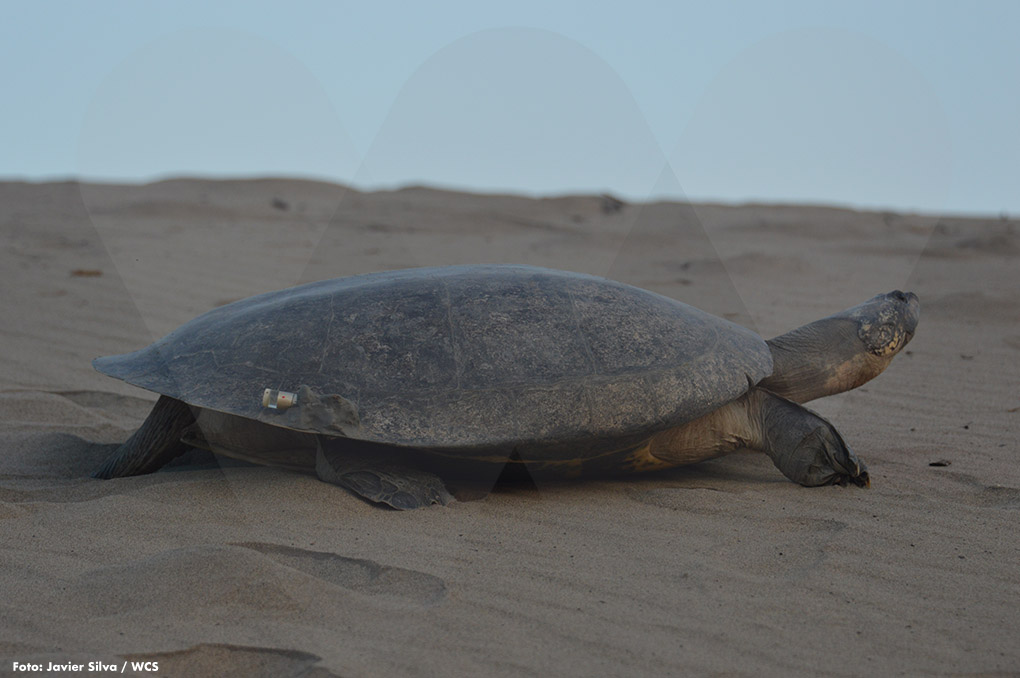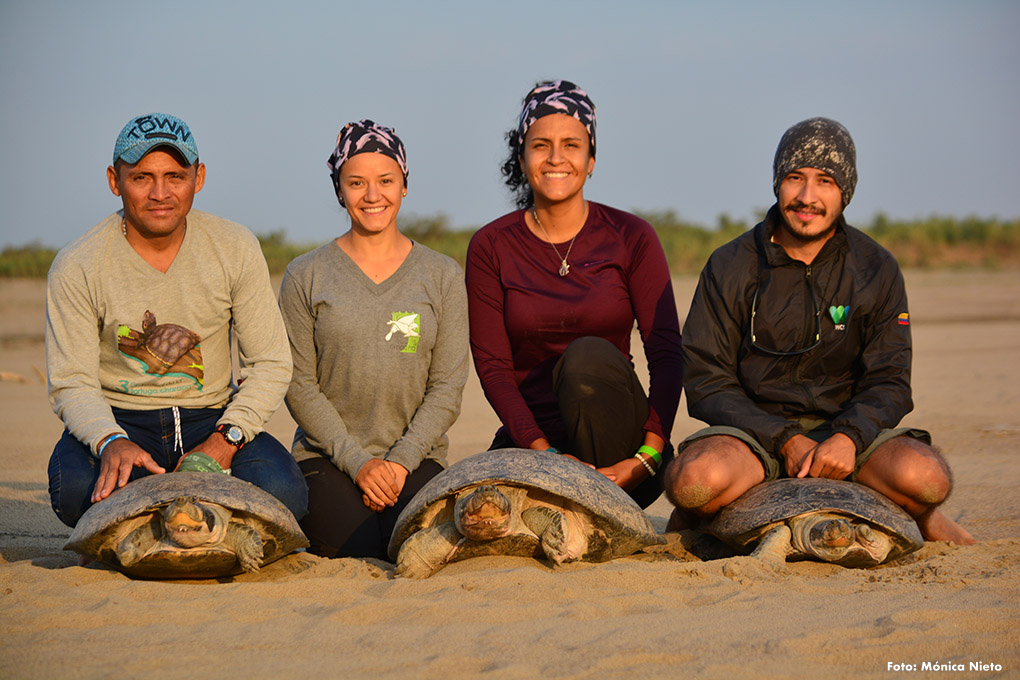It is the first time in Colombia that this technology is used to research the species. The aim is to monitor 15 individuals in the river. Based on the results of their movements, additional actions can be taken for their conservation.
 The acoustic transmitter is placed at one side of the South American river turtle's shell.
The acoustic transmitter is placed at one side of the South American river turtle's shell.
There are hundreds of truths known about the South American river turtle. Some very basic, such as that it not only lives in Colombia, but also in Brazil, Perú, Ecuador, Venezuela and Bolivia. That it is endangered because, for many years, it was hunted in the country without control, to commercialize its meat and eggs. And, among other things, it is clear that it is a vital reptile because it disperses fruits and seeds along the rivers, an activity that helps in the renovation of the flora associated with its habitat.
We have these and many other facts, but biologists who have studied it also have hundreds of doubts. It seems that, as their interest and research increase, so do their questions.
And in an intent to increasingly close those gaps and reveal some of the mysteries that surround this emblematic turtle, a WCS/TSA Colombia team started installing acoustic transmitters in a group of individuals, to monitor their voyages and movements in the Meta River, the first time this technology is used in Colombia to study the species.
The team is working in Casanare, Vichada and Arauca, within the activities of Proyecto Vida Silvestre, in alliance with Fundación Omacha and Turtle Survival Alliance, with support from Ecopetrol, Fondo Acción and the Santo Domingo Foundation. It is led, in the field, by Mónica Nieto, who is working on her research for her Master’s degree in Biology at the Universidad Nacional, with science advice from Germán Forero, Science Director at WCS Colombia.
The questions that have always been around
The behavior of the South American river turtles can be described as “known”, when they leave the water to nest. It is known for certain that every year, approximately between December and March, females go out en masse to dig their nests on the beaches uncovered by the Meta River when its level descends, because this is a season of scant rains.
 The behavior of the South American river turtles is well known when they leave the water. Monitoring will clear doubts on their movements in the river.
The behavior of the South American river turtles is well known when they leave the water. Monitoring will clear doubts on their movements in the river.
They generally choose high and sandy beaches where the eggs they deposit may have, at least, the hope to be safe and relatively hidden from predators. It is even said that, sometimes, they nest in beaches very near to where, in turn, their ancestors nested. But when a South American river turtle finishes laying her eggs, it hides and disappears. It immediately returns to the river, to reappear the following year, driven by its reproductive cycle.
But, what happens with them when they return to the river and vanish? Do they remain close to the beach to watch over the birth of the hatchlings? Do they move away and lose all contact with the nesting site? Will they make long journeys in other rivers or only along the Meta River? Are they migratory? These are some of the questions that, as Germán Forero, Science Director of WCS Colombia says, do not yet have an answer. And they are, at the same time, what give meaning to this monitoring, that has already gone through several stages.
They send signals to aquatic receivers.
The first step was the capture of 8 female specimens of the South American river turtle that had already laid their eggs, to install an acoustic transmitter identified with a number in each of the shells.
As these tagged turtles have moved, they have emitted signals to four receivers placed in fixed and floating stations along the Meta River (passive stations), trying to cover as long a stretch as possible, which today is of at least 80 kilometers. Having the rural settlement La Virgen (Arauca) as reference, the furthest measurement point is Agua Verde, upriver Meta waters.
 In addition to the acoustic signals, the turtles are also monitored manually with the use of a hydrophone.
In addition to the acoustic signals, the turtles are also monitored manually with the use of a hydrophone.
Turtles journeying along this measurement strip will be registered in one of the four receivers, devices that can also identify the number of each transmitter. Accumulated information can be downloaded in the same manner as data on a USB and will allow researchers to determine if a specimen has remained motionless, if it has passed by the same spot several times or, even, if it is on a journey with no return towards the Orinoco or the Casanare Rivers.
In addition to this monitoring, that will last at least a year, the team does manual tracking with a hydrophone that can be submerged in the Meta River waters, with which, from a boat and through an audio equipment known as Mantrak, the turtles with a transmitter can be monitored. This work complements the signals received by the stations.
So near, so far…
Mónica Nieto, who goes out daily at dawn to monitor the turtles, with the help of Remigio Landaeta, an inhabitant of the community, reports that 6 of the 8 turtles have remained for one month in different spots of the river, very near to the beaches where they nested, without any significant movements. Nieto says this could be happening because maybe they found plentiful food and few predators. “It is an odd behavior, but we are waiting to see what happens when the river level starts increasing with the influence of the rainy season (forecasted for June) “.
Depth is another factor that could be influencing their presence in the same area, as well as the existing currents. And, besides, they could be waiting for the birth of their hatchlings, a topic already researched in Brazil, where they proved that the communication between females and their offspring is possible and very intense, even when the latter have not yet hatched. As the females laid their clutches in February, the births are expected for the end of this month (April).
This, however, is placed in doubt by the seventh turtle being monitored, because she is almost 67 kilometers from the place where she dug her nest, upstream, as if she wanted to go to Casanare. The eighth turtle with transmitter has not been located since she was released with the equipment installed.
 Germán Forero, Science Director at WCS, checked the passive water stations (receivers) that receive the acoustic signals sent by the turtles that have a transmitter installed.
Germán Forero, Science Director at WCS, checked the passive water stations (receivers) that receive the acoustic signals sent by the turtles that have a transmitter installed.
All these ideas are part of preliminary analyses. Therefore, Germán Forero explains that “this monitoring will enable the comprehension of some decisive details on the behavior of the species in this river that, until now, are only hypothesis”
The idea is, once the monitoring is completed, to be able to suggest additional protection and preservation measures for the region. “If we know where the females are and have some decisive information on their movements, we will be able to suggest additional strategies for their care, with accurate information”, he added.
In the 19th. Century, as per historical narratives, Alexander von Humbolt saw some riverbanks in the Orinoquia region tinted black with the huge numbers of South American river turtles basking on the beaches. Today, two centuries later, all these scientific efforts led by biologists and supported and encouraged by the region’s inhabitants, are inspired by these anecdotes to contemplate a possible objective: the comeback of huge populations of these river turtles, the biggest in South America. And it is not about matching what the German naturalist saw, but at least to ensure the existence of large groups of turtles, whose valuable lives can be sustainable in time.
 Remigio Landaeta, community member; Camila Duran with F. Omacha; Mónica Nieto, leader of the investigation and Mauricio Correa with WCS, during the installation of the transmitters.
Remigio Landaeta, community member; Camila Duran with F. Omacha; Mónica Nieto, leader of the investigation and Mauricio Correa with WCS, during the installation of the transmitters.